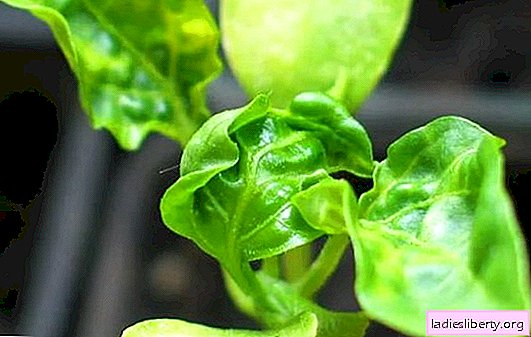
Eggplant is a rather moody culture. When growing seedlings, gardeners face a number of problems, as eggplants are susceptible to various diseases.
How to recognize the disease in eggplant seedlings in order to start treatment on time?
Causes of eggplant seedlings diseases
Most often, eggplants are affected by viral and fungal diseases. Inadequate care and improper growing conditions lead to seedling damage. Disease prevention is easier than cure. Preventive measures are taken at the landing stage. Before sowing, the seeds are disinfected in a solution of potassium permanganate or antifungal drugs. Processing time from 15-25 minutes.
But preplant treatment does not always save you from diseases, as eggplant seedlings are very sensitive to temperature changes, lack of lighting and excess moisture in the soil. It is often impossible to correct the mistakes made, seedlings disappear, and the yield decreases. To prevent this from happening, follow the cultivation agricultural technique for each crop.
Common fungal diseases eggplant seedlings (photo)
Fungal diseases of seedlings occur due to improper watering, insufficient disinfection of the soil and a number of other factors.
Blackleg
A frequent disease of eggplant seedlings, which is characterized by a darkening of the basal neck. The disease develops rapidly, the sprouts wither away before our eyes, without proper treatment, all seedlings die.

It is very difficult to deal with the black leg in seedlings, therefore, pre-planting seed treatment with potassium permanganate is mandatory, in addition, the soil and containers are disinfected.
Most often, plants fall ill in unheated greenhouses, where all conditions contribute to the development of the disease:
• high humidity;
• thickened crops;
• temperature differences.
Before planting seedlings, the room is treated with a solution of bleach, which is prepared from 200 grams of the drug and 10 liters of water.
If the causative agent of the disease has got into the soil, then the plantings are treated with antifungal drugs. With a massive defeat, seedlings are destroyed.
Important! If the soil in the greenhouse is waterlogged, then the beds are sprinkled with wood ash, which will prevent the appearance of a black leg.
Black spotting
This disease is most often found when growing eggplant seedlings at home. One of the reasons for its appearance is excessive watering, which is difficult to regulate in room conditions. Also spotting seedlings appears with thickened plantings or on heavy soil. For growing seedlings, a loose and moisture-permeable substrate is selected.

It is very difficult to cure seedlings, so it is important to determine the disease at the very beginning. If the seedlings are affected, it is necessary to perform a number of measures:
1. Reduce the density of the soil by adding a baking powder to the soil.
2. Check the drain holes.
3. Thin out landing.
4. Reduce watering.
5. Treat seedlings with fungicides.
In advanced cases, plants are destroyed.
Powdery mildew
You can recognize the disease by suddenly fading leaves that dry out and die. If no action is taken, the seedlings will die. The causes of the disease are high air humidity and sudden changes in temperature.
To prevent the development of the disease, make sure that there is no temperature difference. When ventilating, protect plants from drafts, reduce watering and carry out preventive spraying with phytosporin. In addition, treatment with antifungal drugs, which are carried out with an interval of 14 days, will help prevent the onset of the disease in the future.
Gray rot
A novice gardener will not always be able to determine the disease, which negatively affects the seedlings. When the signs are already more noticeable, then it is difficult to cure the disease. Carefully inspect the plants, gray plaque is visible on the shoots and leaves. To get rid of gray rot, several treatments with complex fungicides will be required. In addition, the soil in the greenhouse after growing seedlings must be disinfected.
Eggplant seedlings viral diseases
Late blight
The most terrible disease of eggplant seedlings, which can be recognized by the characteristic rusty spots on the leaves and shoots. Sick seedlings are removed to avoid damage to other plants.

As a preventive measure, plantings are treated with copper-containing preparations or Bordeaux liquid.
Mosaic
Mosaic virus reduces crop yield by 15%. The presence of the pathogen can be determined by the characteristic spots on the leaves, shoots and fruits of the plant, while the leaf plate is deformed.
The mosaic virus is introduced with the affected seeds, passes into the soil. During a dive, the seedlings are affected by the virus, since there is a high risk of mechanical damage.
To protect plants from the virus, pre-planting seed treatment with hydrochloric acid is carried out. To do this, the seeds are soaked in a solution for 20 minutes, then washed in running water and dried.
If the virus is detected, then the entire garden equipment, containers for seedlings are processed. Affected plants are burned.
Non-dangerous diseases of eggplant seedlings
The unsightly appearance of seedlings is not only because it is affected by viruses or fungi. Sometimes this is due to insufficient plant care. Before treating beds with chemistry, determine the disease.
• Purple Eggplant Leaves - there is not enough sunlight for the development of plants, planting is thickened. Thin seedlings, tear off part of the leaves.
• Cracks on the shoots - high temperature when growing seedlings, uneven watering. Adjust the temperature and watering mode.
• Flowers and ovaries fall - high temperature in the greenhouse, pouring cold water, an excess of nitrogen. Top dressing is carried out 14 days after transplanting seedlings into the ground.
• Leaves curl up - lack of potassium in plants. Be sure to feed the seedlings with phosphorus-potassium fertilizers before planting in the ground.
• Leaves are pulled up - lack of phosphorus. Add fertilizer.
• Faded leaves in eggplant seedlings - lack of nitrogen. Seedlings are fed 2 times with an interval of 10 days.
Eggplant seedlings are very tender and need certain conditions for growing: heat, light and moderate watering. It is not easy for a beginner gardener to cope with plant diseases, but the result is worth it. The reward for the work done will be an excellent harvest.
Regularly inspect the plants, monitor the color of the foliage, pay attention to every detail in order to take timely measures to combat diseases. Do not neglect the pre-planting treatment of seeds and soil, observe the density of planting and cultivation agricultural technology - this will save seedlings from many diseases.











